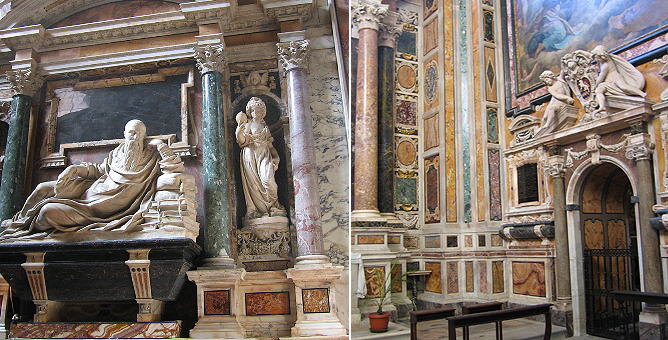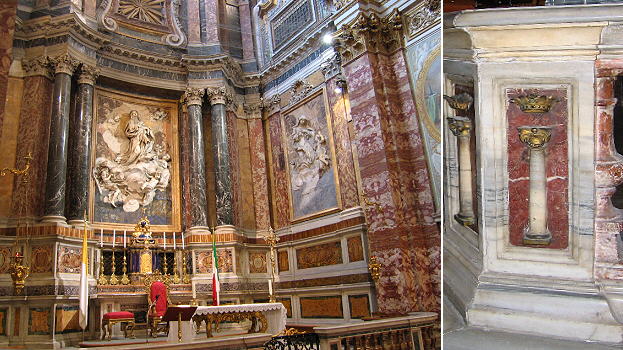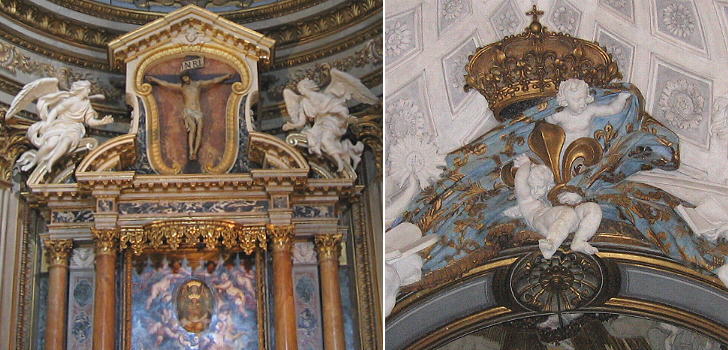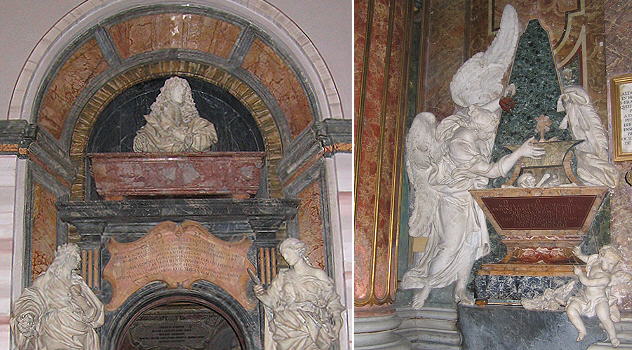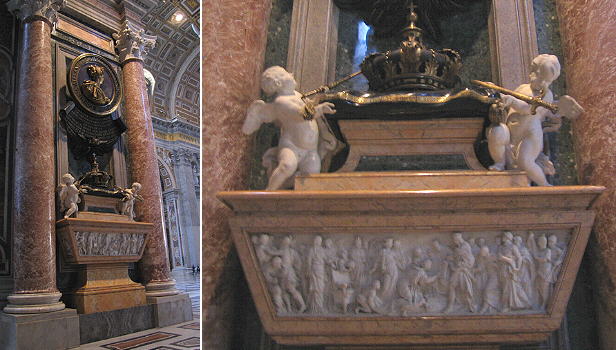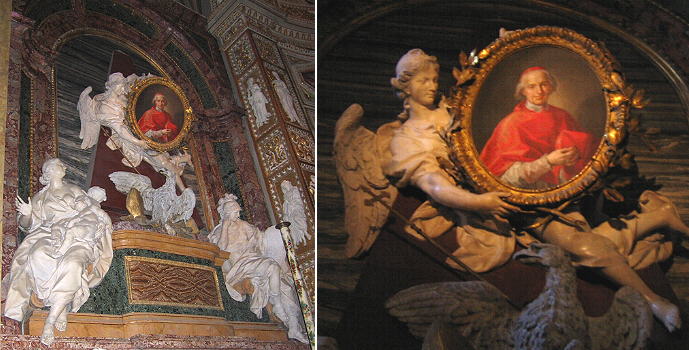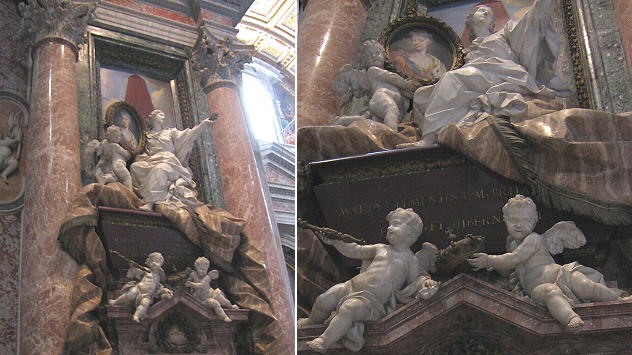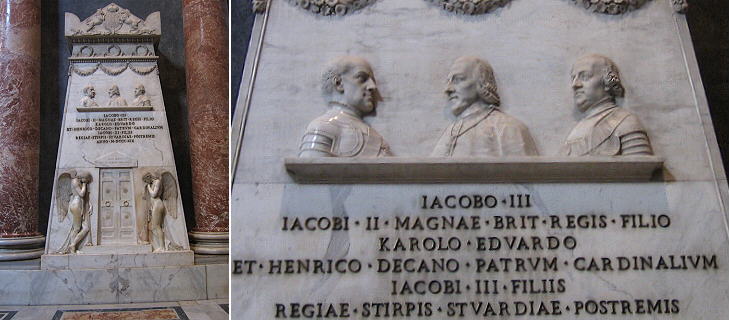  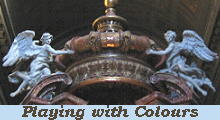 in Baroque monuments in Baroque monuments
Pope Sixtus V (1585-90) can be considered the founder of modern Rome: he opened new streets, he built an aqueduct which after more than 1000 years brought again
water to the hilly part of Rome, he restored the columns of Trajan and of Marcus Aurelius, he relocated the ancient obelisks at the centre of the main squares of modern Rome:
this effort was justified by a religious drive: turn Rome into the Christian City above all: to meet this objective the Pope had a dual approach towards
the pagan heritage of Ancient Rome:
The first example of ample use of coloured marbles can be seen in the chapel named after Sixtus V in S. Maria Maggiore. Clemens VIII (1592-1605) followed the policy of his predecessor and the chapel he dedicated to his parents shines with all sorts of marbles: the design of the monument to his father follows a typical Renaissance pattern: an architectural structure provides a frame for the statue of the dead and the virtues associated to him. Silvestro Aldobrandini, the pope's father is portrayed in a traditional posture which follows Etruscan and Roman models: what is new is the choice of clear and brilliant coloured marbles. Cappella Rucellai, designed just a few years later, would make happy any mineralogist: its walls are almost a catalogue of the different marbles used by the Ancient Romans.
Large unbroken columns after a while became scarce, but for more than a century architects and sculptors could rely on an ample supply of precious stones to decorate the walls of Baroque churches: the introduction of gilded bronze and a careful matching of colours led to more elaborate effects.
Improvements in the stucco technique provided a versatile material which was often used in conjunction with marbles and stones: in some cases it was shaped, painted and gilded in such a skillful manner that it provided a very rich decoration on its own.
In most cases the decoration of a chapel was led by an architect, who coordinated the activity of sculptors, painters, stone-cutters, masons, etc. In case of funerary monuments added to existing chapels the leading role was usually assigned to a sculptor, as in the examples shown above.
Fontana realized that by following the same design he would have given an excessive role to the sculptor of the statue and decided on a very different approach which in a way followed the pattern of other works by Bernini, i.e. the use of bronze elements in combination with white and coloured marbles. His hopes of having opened a new path were short-lived: the monument was soon nicknamed l'orologio (the clock) and regarded as Fontana's great missed opportunity.
Pietro Bracci was the last great sculptor of the Baroque period in Rome, but in most cases his activity was coordinated by an architect; in the monument shown above his sculptures were included in a structure devised by Paolo Posi, an architect who was a specialist in ephemeral buildings such as the Macchine della Chinea (*) or the catafalques used for the funerals of the popes: they were made of timber and papier maché which allowed the most extravagant design. Examples of Posi's skills can be seen in the lavish monument to Cardinal Giuseppe Renato Imperiali and in the monument to Flaminia Chigi Odescalchi. (*) Chinea is the name given to a ceremony during which the King of Naples (or the chief of the Colonna family on his behalf) presented a white horse to the pope, in recognition of his supremacy. The ceremony included fireworks launched from an ephemeral structure (Macchina della Chinea) erected in Piazza SS. Apostoli before Palazzo Colonna.
Pietro Bracci worked almost at the same time at another greatly coloured monument dedicated to Queen Maria Clementina Sobieska: a quite peculiar queen indeed: according to the inscription on her coffin she had been the Queen of Britain, Ireland and France, but she never set foot in her kingdoms. The Sobiesky, after the death of John III Sobiesky, King of Poland had to abandon their kingdom and they set their residence in Rome, where Maria Clementina married James Francis Stuart (James III for the Jacobites), thus acquiring the title shown on her coffin. The lower part of the monument, designed by Filippo Barigioni, shows two angels playing with the regal insignia, a subject which appears also in Carlo Fontana's work. The young woman holding a mosaic, based on a portrait of the queen now in Edinburgh, is a personification of Charity, definitely the virtue most often represented in XVIIIth century monuments: the rich tried in this way to justify their enormous wealth in a society where their role was starting to get challenged: they were trying to sell what today is marketed as the compassionate society.
Antonio Canova had reached such a fame and Pope Pius VII was so grateful to him for his many contributions to the papal state as a sculptor, as an archaeologist and as a diplomat (he had managed to recover most of the papal collections taken by Napoleon), that he was allowed not to "fill" the entire space assigned to him. Canova however paid a tribute to a sculptor of the Baroque period: he portrayed the three Stuarts having in mind the busts of the Frangipane by Alessandro Algardi. You can see a detail of the two angels at the end of a page covering Representation of Death in Baroque sculptures. The image used as a background for this page shows the monument to Gregorius XV in S. Ignazio. Other pages dealing with Baroque sculpture: Statues in the act of praying Monuments showing the dead in a medallion Representation of Death in Baroque sculptures Baroque Angels Three chapels by Gian Lorenzo Bernini Three busts by Alessandro Algardi Baroque Monuments to the Popes Baroque High Reliefs Statues Close to Heaven Embittered Andrew (the statues in St. Peter's octagon) Laughing Masks See also my List of Baroque Architects and my Directory of Baroque Sculpture.
Go to my Home
Page on Baroque Rome or to my Home Page on Rome
in the footsteps of an XVIIIth century traveller.
|
All images © 1999 - 2005 by Roberto Piperno. Write to romapip@quipo.it
